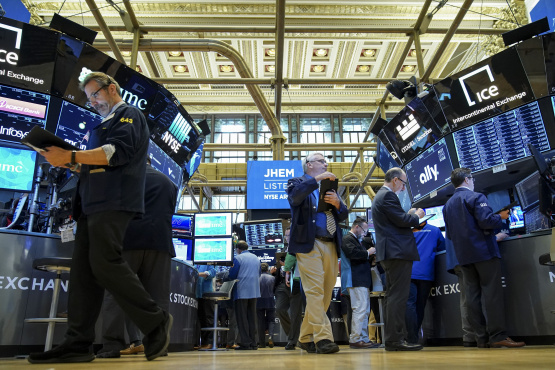S&P 500 hits new intraday high amid a crowded week of economic data, earnings

Stocks rose Monday at the start of week packed with economic data releases and several major company quarterly reports.
The S&P 500 (^GSPC) rose 0.11%, or 3.15 points, as of market close, ending Monday at a new record high of 2,943.03 points. The index’s previous record intraday high was 2,940.91, hit on September 21.
The Dow (^DJI) rose 0.04%, or 11.06 points, while the Nasdaq (^IXIC) rose 0.19%, or 15.46 points.
Broadly stronger-than-expected earnings results – coupled with a strong reading on first-quarter GDP – sent the S&P 500 and Nasdaq to end Friday’s session at record closing highs.
Companies comprising more than half of the S&P 500’s market capitalization have reported first-quarter results, with earnings beating expectations by 6.6%, and 77% of companies outperforming their bottom-line estimates, according to an analysis by Jonathan Golub, chief U.S. equity strategist with Credit Suisse. These figures compare to 5.4% and 71% over the past three years, he added.
[Read More: Earnings season is halfway over and the results are strong]
Investors carried low expectations heading into this earnings season, anticipating a year-over-year decline in corporate profits as the boost from the Trump administration’s corporate tax cut began to fade and the outlook for international economies and trade softened.
With expectations already skewed to the downside, companies that missed first-quarter expectations so far have been disproportionally punished by investors: Shares of companies that missed top- and bottom-line estimates lagged the broader market by an average of about 4.1% following results, while companies beating expectations outperformed by 1.1%, Golub said.
Monday after-the-bell, Google-parent company Alphabet (GOOG, GOOGL) will report quarterly results, along with MGM Resorts (MGM), NXP Semiconductors (NXPI), Tenet Healthcare (THC), Western Digital (WDC).
Meanwhile, reports signaling the state of the U.S. economy will be the focus this week, with the Federal Reserve releasing its latest policy statement Wednesday and the Bureau of Economic Analysis posting the April jobs report Friday. Data abroad will also be of interest to provide a better picture of the state of the global economy, with the Bank of England set to release its own monetary policy decision Thursday, and China’s purchasing managers’ index posted Tuesday.
Over the weekend, profits at industrial companies in China – the world’s second largest economy – were shown to have risen 13.9% in March over the year prior, according to the National Bureau of Statistics. This reversed a 14% decline in industrial profits in the combined first two months of the year, and suggested a positive impact from some of the country’s recently implemented stimulus efforts to help its key manufacturing sectors.
Market participants will be attuned to Federal Open Market Committee’s policy statement Wednesday to gauge members’ responses to recent data about the domestic economy, which grew a much faster-than-expected 3.2% in the first quarter. However, data pointed to inflation holding again below bankers’ 2% target, despite unemployment rates staying low.
As of Monday morning, CME Group’s closely watched FedWatch tool showed markets pricing in a 98% probability that the Fed will leave rates unchanged at the current band of between 2.25% and 2.5%. It also showed a 2% probability that central bankers would cut rates by 25 basis points.
The 10-year Treasury yield rose while the U.S. dollar fell Monday afternoon ahead of the Fed’s decision. The yield on the 10-year Treasury note ticked up 2.5 basis points to basis point to 2.529% as of Monday afternoon, while the dollar index slipped to below 98.
ECONOMY
Personal spending jumped a greater-than-expected 0.9% in March, the Bureau of Economic Analysis reported Monday. Consensus economists anticipated an increase of 0.7%, and the previous month saw personal spending rise 0.1%. The headline jump in purchases – which comprises more than two-thirds of domestic activity – was the largest increase since late 2009.
Meanwhile, real personal income rose a less-than-expected 0.1% in March. This was below the 0.4% gain expected, according to Bloomberg data. For the month prior, personal income rose by 0.2%.
The latest reading on core personal consumptions expenditure – which excludes volatile food and energy prices – was flat month-over-month and up 1.6% year-over-year. The yearly increase was the lowest level in 14 months and marked a slowdown from the 1.7% increase seen in February for core PCE, which serves as the Federal Reserve’s preferred inflation gauge.
“That will reinforce the concerns of several officials that inflation is still too low to be consistent with the 2% target,†and may spur some Fed officials to “seriously [contemplate] interest rate cuts before too long,†said Andrew Hunter, senior U.S. economist for Capital Economics.
—
Emily McCormick is a reporter for Yahoo Finance. Follow her on Twitter: @emily_mcck
Follow Yahoo Finance on Twitter, Facebook, Instagram, Flipboard, LinkedIn, and reddit.
Read more from Emily:
Tech companies like Lyft want your money – not ‘your opinion’
Levi Strauss shares jump more than 30% above IPO price at open
Facebook sued by Trump administration for alleged ‘discriminatory’ ad practices
Boeing 737 Max groundings ‘pressure’ U.S. economic data: Wells Fargo
Recession risks remain muted as fear tracks higher: Report